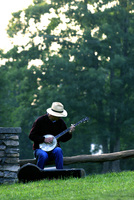 | Back to e-WV
| Back to e-WV
 The West Virginia Encyclopedia
The West Virginia Encyclopedia
 | Back to e-WV
| Back to e-WV
 The West Virginia Encyclopedia
The West Virginia Encyclopedia

Folk music in West Virginia covers a wide range of styles and instrumentation. At West Virginia University’s West Virginia and Regional History Collection, field recordings show that folk musicians played accordion, banjo, drum, fiddle, fife, guitar, hammered dulcimer, dulcimer, harmonica, jew’s harp, mandolin, organ, piano, and saxophone.
There was also a rich oral ballad tradition. Cecil Sharp came to the southern mountains, including southeastern West Virginia, between 1916 and 1918. He was looking for traces of his native England’s fading folkways. What he found was a trove of old songs, sung unaccompanied, that had been passed on from the first Scotch-Irish settlers and could be traced back to the British Isles.
Variants of the ancient ballad ‘‘Lord Lovell,’’ for example, were found by later collectors in Upshur, Clay, Nicholas, Gilmer, Calhoun, and Marion counties. Other songs were descended from poems or popular songs that passed into oral tradition. Also, there were original songs of murder and tragedy, based on real events, that came from the hearts and imaginations of anonymous singers. Folklorist Patrick Gainer believed that most of West Virginia’s traditional music came down as a cappella singing, sung by practically everyone as part of everyday life and with no instrumental accompaniment.
Although the influence of the British Isles predominated, the music had other roots, as well. Germans migrated from Pennsylvania into present West Virginia in the 18th and 19th centuries. While they have been long assimilated into the larger culture, they left a mark on certain tunes in fiddle repertoires in the state and on parts of West Virginia’s dulcimer heritage.
African-Americans were brought as slaves to work in salt factories and on farms. Later they worked as miners and railroad workers. The black railroad experience has brought us a wealth of songs, and a genuine West Virginia folk hero, John Henry. Henry was a steel-driving man, swinging his hammer to drive long steel bits into rock to make holes for explosives. He met his death in a race with a steam drill at the Big Bend Tunnel on the C&O Railroad in Summers County. Another song, ‘‘John Hardy,’’ now a bluegrass banjo standard, commemorates the rowdier side of labor. The real John Hardy, also an African- American, killed a man in a card game in a McDowell County coal camp. He was hanged for it at Welch in 1894. Twenty years later, the influence of black blues musicians could be heard in 78 rpm recordings of a white country guitar player from Logan County named Frank Hutchison.
The exploitation of West Virginia’s abundant natural resources brought other nationalities from Southern and Eastern Europe. The land itself drew the Swiss to Helvetia in the late 1800s. There the Swiss farm families listened to marches, Old World favorites, and popular American tunes played by the community brass band. Waltzes competed for floor time with square dances called to Randolph County fiddle tunes.
In Marshall County, the Perkovic family preserved their Croatian heritage of Tambouritzan music on native instruments. They performed on radio station WWVA and toured the coalfields on a semi-professional basis. Some years later, Doc Williams became a mainstay of the Wheeling Jamboree weekly radio program on WWVA. Williams, whose roots also were in Eastern Europe, blended polkas and accordion music into his successful country music career.
Religion has sometimes been at odds with the wild and wooly aspects of West Virginia music, but religion provided its own powerful contribution. A frontier preacher would ‘‘line out’’ how a song went, saying the words for the congregation to repeat in song. This changed in most churches in the 19th century, when singing schools developed. Traveling teachers taught the ‘‘shape-note’’ method to local congregations. Gospel singing, black and white, has been an important part of West Virginia worship ever since. For years, Mount Nebo in Nicholas County has been the site of several large gospel singing conventions each summer.
Community music is still thriving. Square dancing is alive and well in West Virginia, and community centers and private clubs across the state present bluegrass and old-time music. Charleston, the capital city, is home to a community brass band.
The folk revival of the late 1950s and ’60s, followed by the back-to-the-land movement of the ’60s and ’70s, brought renewed interest in West Virginia culture and local music. Gatherings such as the West Virginia Folk Festival at Glenville mushroomed as young people from the North and East flocked to hear authentic fiddling and see flatfoot dancing. Other festivals were established, including the Stonewall Jackson Jubilee at Jackson’s Mill and the Vandalia Gathering at the Capitol Complex in Charleston.
West Virginia music and musicians began to reach a larger audience. Small record labels recorded the music of heretofore obscure local fiddlers and singers. A film, The Morris Brothers Old-time Music Festival, captures part of this exciting time.
One such project was undertaken with the cooperation of the Hammons family in Pocahontas County by folklorists from the Library of Congress. This work provided the full context of West Virginia folk music, including stories and family and local history, a record of the joy, sorrow, and hard work of everyday lives.
Written by Paul Gartner
Milnes, Gerald. Play of a Fiddle. Lexington: University Press of Kentucky, 1999.
Cox, John Harrington. Folk-Songs of the South. Cambridge: Harvard University Press, 1925.
Gainer, Patrick W. Folk Songs from the West Virginia Hills. Grantsville: Seneca Books, 1975.